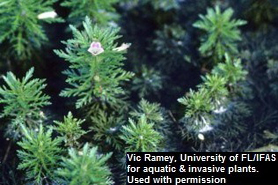Asian marshweed
(Limnophila sessiliflora)
An aquatic perennial herb that can exist in a variety of aquatic habitats. It is fast-growing and can regrow from fragments. When in high densities it can shade out other submerged aquatic species.
Other names for this plant include:
- Common names: Ambulia
- Scientific names: Ambulia sessiliflora, Hottonia sessiliflora, Stemodia sessiliflora, Terebinthina sessiliflora, Stemodiacra sessiliflora
Classification in Wisconsin: Prohibited
- Ecological Threat
-
- It invades freshwater lakes, reservoirs, ponds, marshes and slow-flowing streams and rivers making boating, fishing, and almost all other water activities difficult.
- A dense growing habit from the bottom of the water body to the surface can crowd out native aquatic vegetation.
- A competitive aquatic plant that can tolerate low light levels and grow in water up to 12 feet deep.
- Identification
-
Leaves: Above water, the leaves are dark green, more-or-less lance-shaped; in whorls of 5-8 leaves about the stem. Margins appear to be torn irregularly. Submersed leaves are finely divided and feathery, with segments opposite.
Flowers: Small and solitary in leaf axils in the uppermost parts of the stems, above the water. Five fused petals are 5-10 mm long and blue, violet, pink or lavender, upper lip white or pink.
Fruits & seeds: Forms capsules, ellipsoid, with up to 150 seeds.
Roots: From stem nodes, numerous.
Similar species: Vegetation appears similar to other submerged aquatic plants at first glance, particularly fanworts.
- Control
-
Mechanical: Removal by hand or machine is a practical control method only for small areas or when numbers are low. Plants can regrow from stem fragments so care must be taken to gather and destroy all plant parts if removed.
Chemical: Registered aquatic herbicides can provide temporary control of Asian marsh weed in small-scale applications. 2,4-D has been effective. Application of aquatic herbicide requires a permit.
- Resources
- Sources for content:
- Global Invasive Species Database Factsheet [exit DNR]
- The University of Florida Center for Aquatic and Invasive Plants: Factsheet [exit DNR]



